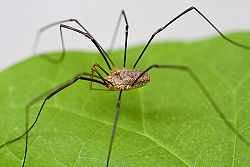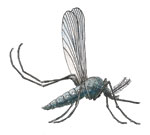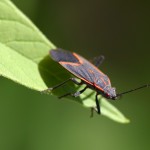READY TO GET STARTED?
REQUEST A FREE ESTIMATE
Fill out the form below or call (888) 466-7849 for a free, no-obligation estimate.
 It may be one of the most easily identifiable pests but it’s also commonly misrepresented. Granddaddylonglegs, or daddylonglegs, are often thought to be spiders but are actually harvestmen. Harvestmen get their name because that is when they are usually seen…during harvest time. There are about 150 species of daddylonglegs in North America.
It may be one of the most easily identifiable pests but it’s also commonly misrepresented. Granddaddylonglegs, or daddylonglegs, are often thought to be spiders but are actually harvestmen. Harvestmen get their name because that is when they are usually seen…during harvest time. There are about 150 species of daddylonglegs in North America.
When you spot a granddaddylongleg, with its long and thin legs, it is not hard to see where the “longlegs” part of their name comes from. They use their infamous legs to catch insects, spiders, and plants that they feed on. They are found around structures of homes and buildings, and tree trunks, presumably looking for food. Inside of a structure they are typically found in garages, basements, crawlspaces, or other damp areas of the home. You won’t usually find them in the common living areas.
Another common misconception about daddylonglegs is that they are poisonous or venomous…neither of which are true. They are not harmful to humans or animals, they won’t even bite.
Did you know that granddaddy long legs weren’t spiders?
Call Northwest Exterminating to get rid of grand daddy long legs or other pests in your home or business.
 It may be one of the most easily identifiable pests but it’s also commonly misrepresented. Granddaddylonglegs, or daddylonglegs, are often thought to be spiders but are actually harvestmen. Harvestmen get their name because that is when they are usually seen…during harvest time. There are about 150 species of daddylonglegs in North America.
It may be one of the most easily identifiable pests but it’s also commonly misrepresented. Granddaddylonglegs, or daddylonglegs, are often thought to be spiders but are actually harvestmen. Harvestmen get their name because that is when they are usually seen…during harvest time. There are about 150 species of daddylonglegs in North America.
When you spot a granddaddylongleg, with its long and thin legs, it is not hard to see where the “longlegs” part of their name comes from. They use their infamous legs to catch insects, spiders, and plants that they feed on. They are found around structures of homes and buildings, and tree trunks, presumably looking for food. Inside of a structure they are typically found in garages, basements, crawlspaces, or other damp areas of the home. You won’t usually find them in the common living areas.
Another common misconception about daddylonglegs is that they are poisonous or venomous…neither of which are true. They are not harmful to humans or animals, they won’t even bite.
Did you know that granddaddy long legs weren’t spiders?
Call Northwest Exterminating to get rid of grand daddy long legs or other pests in your home or business.
What are the tiny red bugs crawling around my windows?
This is a common question that we get in early spring and late fall. Clover mites are found in warm, sunny places which is why you usually see them around your windows and crawling on your curtains. Clover mites are smaller than the tip of a pencil which allows them to fit into the smallest cracks and crevices around a structure. They are oval shaped with 8 legs. Their 2 front legs are longer than the rest and protrude forward which can be confused with antennae.
Clover mites can be alarming to homeowners because they gather in large numbers but there is no need for alarm. Clover mites do not bite or carry diseases, however they can cause skin irritation to some with sensitive skin. (These are not to be confused with chiggers which look similar but get into the skin and itch.) They do not damage furniture or pursue your food. Clover mite eggs lay dormant in the summer months and hatch in temperatures of 85 F or below. They are attracted to warm, sunny places which leads them to the windows in your home. Clover mites are often identified by the red stain they leave once they have been squashed. The red substance is the pigment in their color, not their blood. Grass and clovers are their main source of food.
There are simple ways to get rid of clover mites in your home. The best way is to vacuum them up. As with any vacuumed pest, make sure that you dispose of the bag immediately in an outdoor trash can. Disposing of the bag is always recommended but is especially an issue when it comes to clover mites because they are so small and can escape from the bag into your home. Another way to get rid of clover mites is to place sticky traps around your windows. As always, prevention is your best option. Clover mites feed on fertilized lawns, so if you are seeing an infestation cut back on the fertilizer. Remove grass that has direct contact to your structure. Instead, use soil, gravel, or mulch because clover mites have difficulty moving on bare, loose terrains. Make sure all window screens are tight fitting. Seal any cracks around the outside of the structure and use weather stripping on entrance areas.
If you are having a consistent problem with clover mites or other pests, it’s best to call Northwest Exterminating. We will ensure that your issue is identified and a customized plan is created for treatment of clover mites.
Are these small red bugs showing up in your home?
 The early spring has brought pests out in full force and we suspect that they will not be slowing down anytime soon. Not only are bugs annoying but they’re a health concern as well.
The early spring has brought pests out in full force and we suspect that they will not be slowing down anytime soon. Not only are bugs annoying but they’re a health concern as well.
Pests can carry diseases and cause areas to be unsanitary. These are issues of concern for both homes and businesses. Even the cleanest homes can have bug problems in an environment like this. Carpenter bees, mosquitoes, ants, yellow jackets, silverfish, and other pests have recently been invading properties. If you’re in the Atlanta, Columbus, Savannah, or Nashville area, call Northwest Exterminating. Our NorPest Green program was developed exclusively by Northwest Exterminating to get rid of pests using the lowest environmental impact possible. A Northwest representative will develop a customized plan to target those pests while maintaining the health of your home.
We are strategically placed throughout Georgia and Tennessee to service all areas of Georgia as well as parts of Tennessee, Alabama, and South Carolina. Visit us online or call 888.466.7849 to find the location nearest you.
 With the abnormal temperatures this Winter we are seeing abnormal pest movement. Boxelders are typically a pest that is active in the colder months when they enter homes for warmth and food. Although temperatures are warmer than usual, we are still getting calls about boxelder bugs being in people’s homes.
With the abnormal temperatures this Winter we are seeing abnormal pest movement. Boxelders are typically a pest that is active in the colder months when they enter homes for warmth and food. Although temperatures are warmer than usual, we are still getting calls about boxelder bugs being in people’s homes.
The best time to have an exterminator treat for boxelder bugs is in the fall when they are trying to find shelter. Boxelder bugs like to overwinterize in warm areas, cracks and crevices of trees, rocks, and other natural areas. Our homes are a perfect habitat for them.
In the fall, it is best to apply a repellant, such as NorPest Green, that would keep them out of the structure. A micro cap is an alternative option that is effective but cause the insects to die inside the structure. Our pest professionals will use NorPest Green along the walls and voids of a structure and/or a type of illumination device that can be used in the attic with a glue board can also help in the elimination of boxelders.
But since Spring is around the corner and we continue to have calls for these pests, a micro cap is the best option. A micro cap works well in the Spring because it allows the pest to escape and die outside rather than inside the home. Now is the ideal time to ensure that your home is properly sealed and caulked with expandable foam. Using screens on doors and windows can also be beneficial.
In the Summer months, a mosquito application helps keep numbers down since they like to go through their molts on vegetation such as Maple trees and grape vines.
Have you been seeing boxelders inside your home?
Has the abnormal temperatures affected your home in any other ways?